
The Turmeric crazy is everywhere!!!
Though, for once, Turmeric is actually a genuinely good example of a food which is only just starting to get the respect it deserves on a global scale.
It’s been used in Ayurvedic medicine for, literally, a countless number of years, but outside of its home in Asia, particularly India, it’s long been known as just a spice which is used to make curry.
Maybe turmeric’s association with hot, spicy food has hindered its widespread and well-deserved adoption to a food which is actually highly beneficial to overall health.
Especially effective for certain medical conditions, it can be consumed by anyone regardless of their culinary preferences.
Quick Jump
So......... What Does Turmeric Taste Like?
Turmeric is a very useful herb that has many health benefits.
However, it doesn’t taste very good at all and almost no-one would ever want to eat it raw because of its pungent taste.
If you can imagine that turmeric is used in pickles and mustard, as well as curries so you get the idea
So, if you are planning on making use of this wonderful but quite foul tasting little beauty, then you're going to want to either take it as a supplement of fast forward to the recipes we have below to dilute it down
Read Our Ultimate Guide To The Best Turmeric Supplements HEREHow long does it take for turmeric to work?
After the issue of taste, the other question many people want to have answered is how long does it take for turmeric to work? The only concrete answer to this question is “it depends”. It depends on how you consume your turmeric and it also depends on what you mean by “working”, for example, if you’re simply consuming turmeric because you want to improve your diet and generally lead more of a healthy lifestyle then you may well notice a difference more quickly than someone who is using it to treat a particular medical condition.
If you’re still reading this article, we’ll assume that you’re at least curious to know more about turmeric so we’ll take a step back and fill in some of the blanks.

Turmeric basics
Turmeric is a spice, meaning it comes from the root of a plant or, in this case, more accurately, a rhizome. In principle you can eat turmeric raw, it won’t do you any actual harm, but there are probably only a tiny number of people who could even tolerate the taste, let alone enjoy it.
Raw turmeric is bitter, really bitter, as in, if you’re the sort of person who can happily eat raw lemon, there’s still a good chance you would find turmeric too bitter for your taste. You can use fresh turmeric in cooking, in much the same way as you can use fresh ginger, although the actual feasibility of this will depend partly on your ability to buy fresh turmeric where you live, partly on your cooking habits and partly on your tastes in food.
Outside of India, or at least Asia, probably the most common ways of consuming turmeric are as a powder (spice) or as a tablet/capsule, basically as a natural supplement. As is generally the case, there are no “rights and wrongs” about any of these, it’s basically about working out what fits your needs, wants and lifestyle.
Fresh turmeric
Before you can use fresh turmeric you need to peel it and then cut it in some way. A standard vegetable peeler will do just fine for turmeric but if you don’t have one, you may find it best to use the edge of a spoon rather than a paring knife.
Turmeric is usually grated but if you prefer you can just cut it up into slices, cubes or basically whatever takes your fancy. In principle, you can use fresh turmeric in the same way as you use dried turmeric, however, there are some dishes where it may be a better choice, depending on your tastes.
Smoothies and juices (as opposed to teas)
Basically if you’re just sticking a pile of veggies and/or fruits into a juicer then you may find it easier to judge proportions with fresh turmeric rather than adding powder, tasting, adjusting and repeating until you get the right amount. One great ingredient to partner the turmeric is Bananas
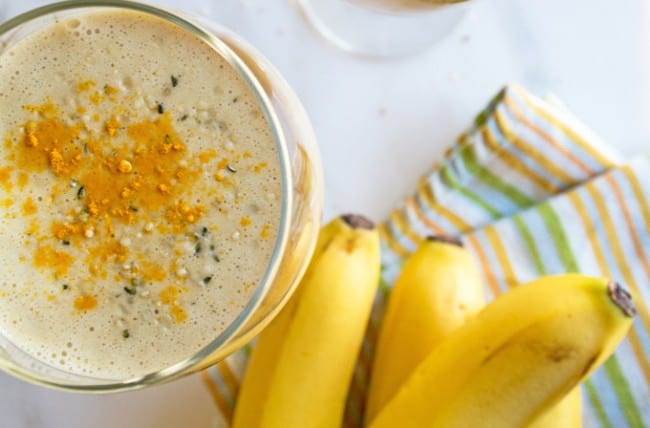
Marinades and (salad) dressings
Essentially fresh turmeric root can look good in a marinade or dressing as well as tasting good.
Stir fries, egg dishes, and savory yogurts
Fresh turmeric can really pep up these basic dishes by adding texture and colour as well as flavor.
For the record, you can use powdered turmeric for all of these purposes, it’s just that fresh turmeric can give that bit extra something.
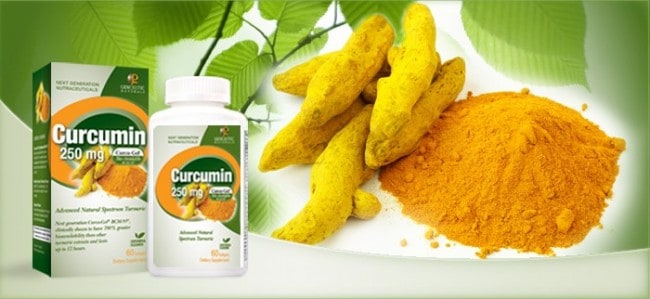
Turmeric Tablets and capsules
If you want all the benefits of turmeric (or pure curcumin) without the taste, then tablets and/or capsules are indisputably the way to go, particularly since many of them have added black pepper to improve absorption. Tablets and capsules are also the way to go if you’re looking for precision dosing, perhaps for medical reasons. The down side of tablets and capsules is that this convenience and accuracy comes at a price, literally. Having said that, because turmeric supplements are easy and affordable for companies to produce, they tend to be available at reasonable prices.
Read Our Ultimate Guide To The Best Turmeric Supplements HERE
Powdered turmeric
This is where life starts to get more interesting since powdered turmeric is a pantry staple which is probably available to just about anyone, just about anywhere. It also has a variety of uses in both foods and drinks.
Foods
This is the traditional use for turmeric and once you start to use it you’ll begin to understand why. Even though dried turmeric is bitter, it is nowhere near as bitter as fresh, raw, turmeric. In fact, it becomes more on a par with ginger (in terms of strength, obviously the actual flavor is different) and just like ginger, it can be used for both sweet and savory dishes.
In other words, if you’re still holding onto the idea that turmeric is the curry spice, it’s time to reassess. You can certainly use turmeric for curries, in fact, you may find it saves you money to do so since ready-made curry sauces (dried or in jars) tend to come with prices which are rather higher than their ingredients’ list would suggest and, of course, if you make your own curry sauces, you’ll have total control over what goes in it, but please don’t peg turmeric as being only for curries.
If you still need convincing to venture into the world of turmeric powder in your food, here are some tips to help.
Whenever you use turmeric, be it in a savory dish or a sweet one, aim to include black pepper if at all possible to improve your body’s absorption of the active ingredients in turmeric.
Read Our Ultimate Guide To The Best Turmeric Supplements HERETurmeric partners very well with cardamom, cinnamon and cilantro as well as ginger. With the exception of cilantro, which is best kept for savory dishes, all of these spices can be used in both savory and sweet dishes.
The key to adding them to sweet dishes is to include plenty of sweeter ingredients to counterbalance them, honey is the obvious choice, coconut, pineapple and chocolate are all increasingly popular and you can also use plant syrups such as maple syrup.
In fact, you can use whatever you like, there is nothing whatsoever to stop you using, for example, a sweet fruit jelly if you wanted to.
To pile on the superfoods, add turmeric to quinoa. It’s a great partnership in terms of taste and texture and the nutritional value is amazing.
Sweet potato and squashes are also both good partners for turmeric as the presence of turmeric helps to balance out all the sweetness and give it a bit of bite.
Mix turmeric with tahini for an easy, tasty and healthy dressing.
Add turmeric to a classic lentil and vegetable soup for an instant boost in nutrition as well as flavour.
Sprinkle some turmeric into plain yogurt for an amazing salad dressing
When it comes to desserts and sweet treats, look for recipes which call for ginger and then try substituting turmeric or mixing it with ginger. Otherwise, just use your imagination and add turmeric to anything you feel could benefit from being less sweet or anything to which you want to add richness and complexity on the understanding that if this makes it too bitter, you can add a sweetening agent.
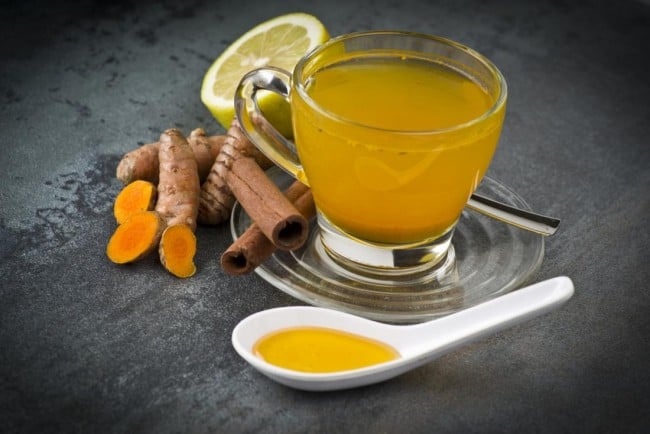
Turmeric drinks
There are basically three ways you can drink turmeric - turmeric tea, turmeric milk, also known as golden milk or turmeric juices. Here are some hints about your options.
Turmeric tea
One option is simply to buy a ready-made turmeric tea blend off the internet (or your local health store) and this option could seriously be worth considering, especially if you live in a small space with minimal room to store ingredients. If, however, you do want to make your own, then a basic recipe would be as follows:
1 mug of water - just off the boil (i.e. hot but drinkable)
1 teaspoon turmeric powder
1 pinch black pepper
Lemon juice (optional but will help clean your body from the inside)
Honey (preferably runny)
Add the turmeric and black pepper to the hot water and then add the lemon juice if you wish. Taste and add honey to sweeten.
This is possibly the most basic turmeric tea there is, as always, feel free to use your imagination. For example, you could add in a pinch (each) of ginger and/or cinnamon. You could also make turmeric tea with actual tea instead of water. Green tea would probably be a better choice than black tea, both in terms of taste and in terms of a lower level of caffeine, but again, it’s up to you.
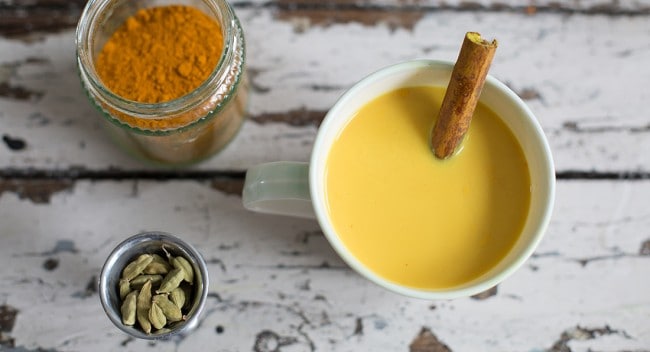
Turmeric milk aka golden milk
Golden milk is possibly the most common way to enjoy turmeric as a drink, partly for traditional reasons and partly because it is so easy (which may well be a large part of the reason why it became a tradition in the first place). To make it you need:
1 cup water
½ cup turmeric powder
1 teaspoon black pepper
4 tablespoons coconut oil (preferably virgin).
Heat the water and add the turmeric powder and black pepper, leave to simmer until the mixture becomes a paste. Allow to cool and add the coconut oil.
NB: For this recipe we strongly suggest you use standard coconut oil rather than MCT oil. If you really want to, you could add MCT oil to your drink when you go to use it.
To make the actual golden milk, you add the paste to a milk-type liquid. We suggest you use half a teaspoon of paste per cup of liquid to start with and then see how you go, as always you can add other ingredients to the golden milk as well, for example lemon juice, honey and/or other spices.
Traditionally golden milk is made with coconut milk, but you can use another nut milk, soya milk or even ordinary milk.
The paste will keep in the fridge for up to two weeks (in an airtight jar), so you can make it in fairly large quantities. It’s not really suitable for freezing, but it’s so easy to make this is unlikely to be a huge issue (or an issue at all).
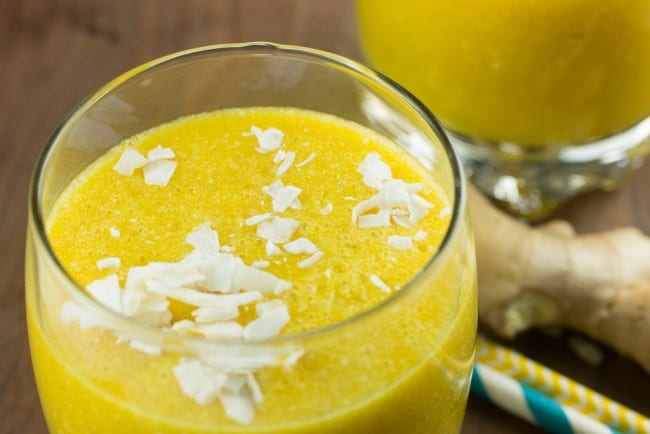
Turmeric juices and smoothies
These days the internet is full of recipes for turmeric drinks if you want some inspiration to get you started, or, if you’re in the mood for adventure and experimentation by yourself, then the guideline is to make sure that there is enough sweetness in your drink from other ingredients to make it palatable to you (unless you really like your drinks bitter).
Pineapple and coconut are both great partners for turmeric as are carrots. Orange juice can be good, it just needs to be on the sweeter side, rather than more citrus. Bananas are a great addition to any fruit drink or smoothie and particular to ones which include turmeric as their taste is very mild and more creamy than sweet so they add lots of body and texture (as well as goodness) and help to create a bridge between bitter flavors, such as turmeric, and sweet ones, such as fruit.
Kiwi fruit also goes well with turmeric and, perhaps surprisingly, kale can be put into sweet drinks as well as more savory, vegetable-based ones. Then, of course, you can add all the other ingredients of your choice.

Bonus suggestion - turmeric hot chocolate
Take a look at any shop selling a range of hot chocolates and you’ll see that chocolate is frequently partnered with spicy ingredients, in fact chile hot chocolate is a popular favourite, so this might be a tasty way for you to get your health-giving turmeric.
Read Our Ultimate Guide To The Best Turmeric Supplements HEREBest Seller Turmeric Supplement
Fitness fanatic and always on the move. Carly is a certified personal trainer and currently teaches spin class, Zumba, and Body Pump amongst a few others. Carly has a PhD/MSc in Sport and Exercise Nutrition so she really knows her stuff and has worked in fitness and health all her life. We are honoured to have her as a member of the team. Carly has an infectious laugh, loves terrible, terrible jokes and her dog Trevor and often works with a local mental health charity























